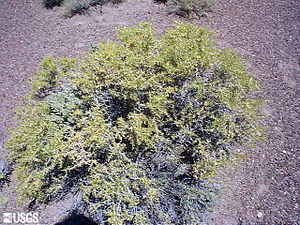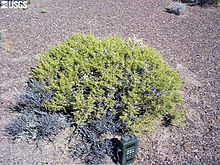Sarcobatus
| Sarcobatus | ||||||||||||
|---|---|---|---|---|---|---|---|---|---|---|---|---|

|
||||||||||||
| Systematics | ||||||||||||
|
||||||||||||
| Scientific name of the family | ||||||||||||
| Sarcobataceae | ||||||||||||
| Behnke | ||||||||||||
| Scientific name of the genus | ||||||||||||
| Sarcobatus | ||||||||||||
| Nees |
Sarcobatus is the only genus ofthe Sarcobataceae family in the order of the carnation-like (Caryophyllales) within the flowering plants . The areas of only two species are only in southwestern North America including northwestern Mexico. There are halophytes in arid areas. In some areas they are invasive plants .
description
Vegetative characteristics
Sarcobatus species grow deciduous, upright, richly branched shrubs . The plant parts can be hairy downy. The branches are usually reinforced with one, rarely two thorns per node . The sessile leaves are usually alternate in long shoots or close together on short shoots ; they are fleshy, succulent with a smooth leaf margin. The leaves are green in contrast to the other species in the same habitat , which all have gray leaves. There are no stipules.
Generative characteristics
They are mostly single-sexed ( monoecious ), rarely double-sexed ( dioecious ). There are no supporting or cover sheets. Ten to 40 male flowers are arranged in a cylindrical, catkin-like inflorescence . The male flowers lack bracts ; they usually have only two to four (rarely one or five) free stamens . The female flowers are solitary or in pairs in the leaf axils; they have (two) bell-shaped fused bracts. Two carpels are in a partially permanent, einfächerigen ovary grown. In the ovary there is only one ovule in the basal placentation . There is a stylus with two papillary scars.
The achenes , covered by the fleshy bracts , are winged. The circular, flattened seed has a membranous, translucent seed coat. The diaspores are spread by the wind.
The base chromosome number is n = 9.
Systematics
The type species was first described in 1838 as Batis vermiculatus by William Jackson Hooker in Flora Boreali-Americana , 2 (9), p. 128. The genus name Sarcobatus was first published in 1839 by Christian Gottfried Daniel Nees von Esenbeck in Journey to the Interior of North America in the years 1832 to 1834 , 1, p. 510. The renaming of the then only species in Sarcobatus vermiculatus took place in 1848 by John Torrey in Notes of a Military Reconnoissance , p. 149. The genus Sarcobatus was monotypical until 1892 Frederick Vernon Coville published a second species from western Nevada . A synonym for Sarcobatus Nees is Fremontia Torr. Earlier this genus was in the tribe Sarcobateae within the subfamily Salsoloideae of the family Chenopodiaceae Vent. (with Cronquist, Dahlgren or Takhtajan) classified. The Sarcobataceae family was set up in August 1997 by Heinz-Dietmar Behnke in Taxon , 46, p. 503. Within the order of the Caryophyllales , the Sarcobataceae form a clade with the Phytolaccaceae and Nyctaginaceae .
The family contains only one genus with only two species:
- Sarcobatus baileyi Coville (Syn .: Sarcobatus vermiculatus var. Baileyi (Coville) Jeps. ): It thrives on alkaline soils in semi-arid or arid basins up to hills in mixed bushes only at altitudes between 1200 and 1900 meters only in Nevada.
- Sarcobatus vermiculatus ( Hook. ) Torr. (Syn .: Batis vermiculata Hook. ): It populates the entire area of the genus.
The two species can co-exist in Nevada habitats and occasionally F1 hybrids have been found that are morphologically intermediate between the two species, but with malformed leaves and inflorescences; they seem sterile.
swell
- The family of Sarcobataceae in APWebsite. (Section systematics)
- The Sarcobataceae family at DELTA by L. Watson & MJDallwitz.
- Matthew H. Hils, John W. Thieret & James D. Morefield: Sarcobatus in the Flora of North America : Online. (Section description and systematics)
Individual evidence
- ↑ Sarcobataceae in the Germplasm Resources Information Network (GRIN), USDA , ARS , National Genetic Resources Program. National Germplasm Resources Laboratory, Beltsville, Maryland.
Web links
- JH Kirkbride Jr., CR Gunn & MJ Dallwitz: Family Guide for Fruits and Seeds , 2006 ( online )
- Entries about Sarcobatus in Plants For A Future
- Description and images of Sarcobatus vermiculatus . (English)
- A lot of information about Sarcobatus vermiculatus . (English)
- Profile of Sarcobatus vermiculatus with pictures. (English)
